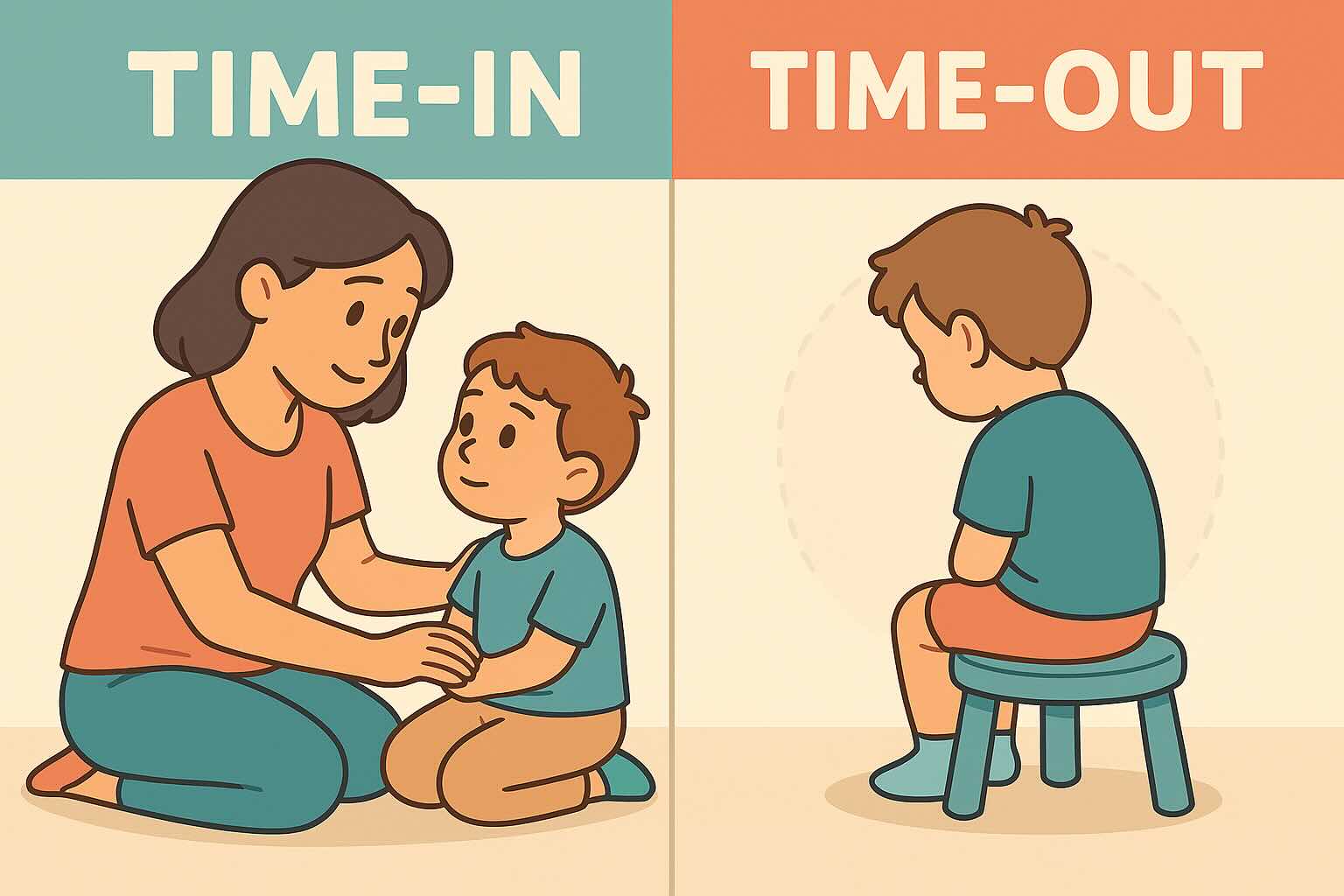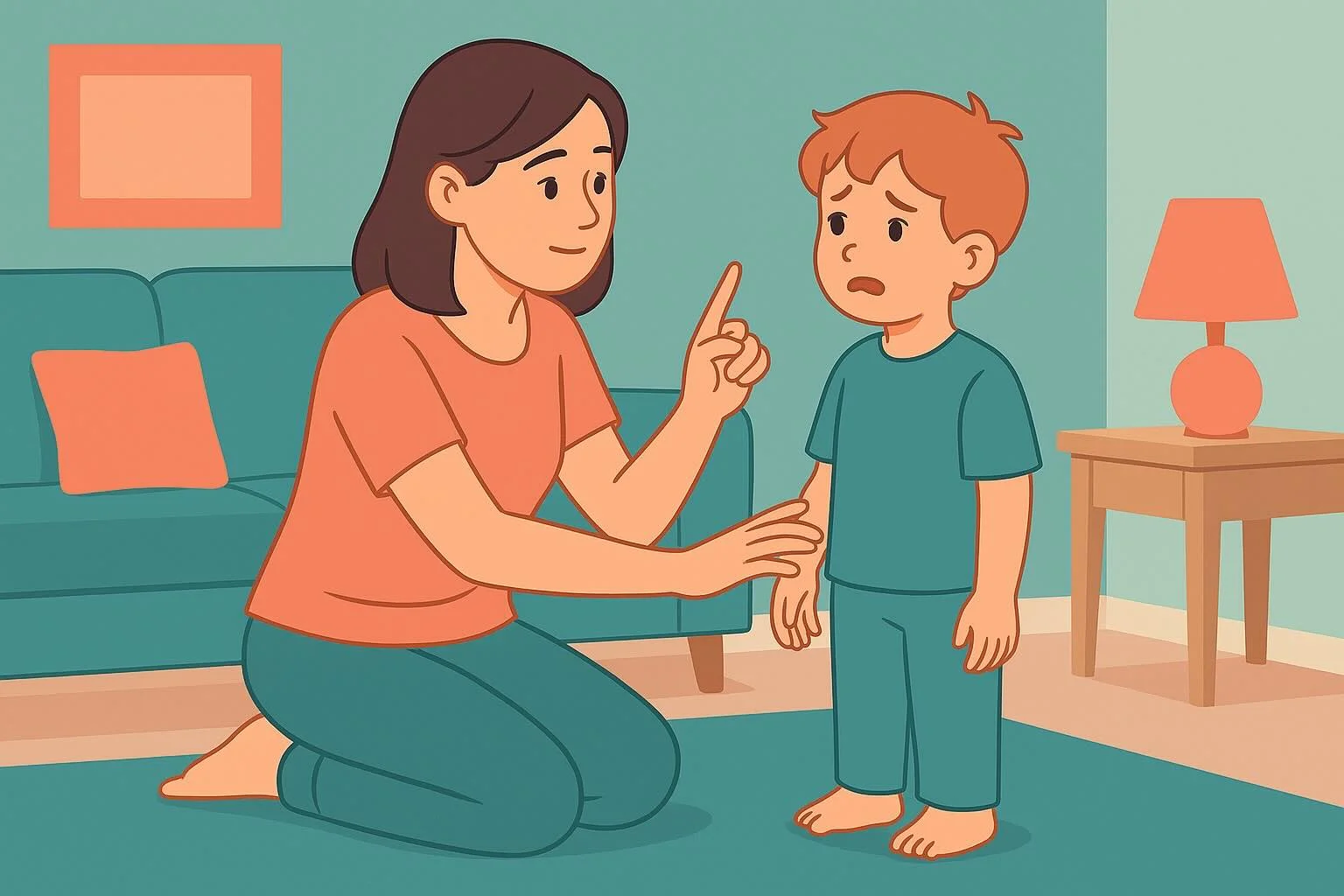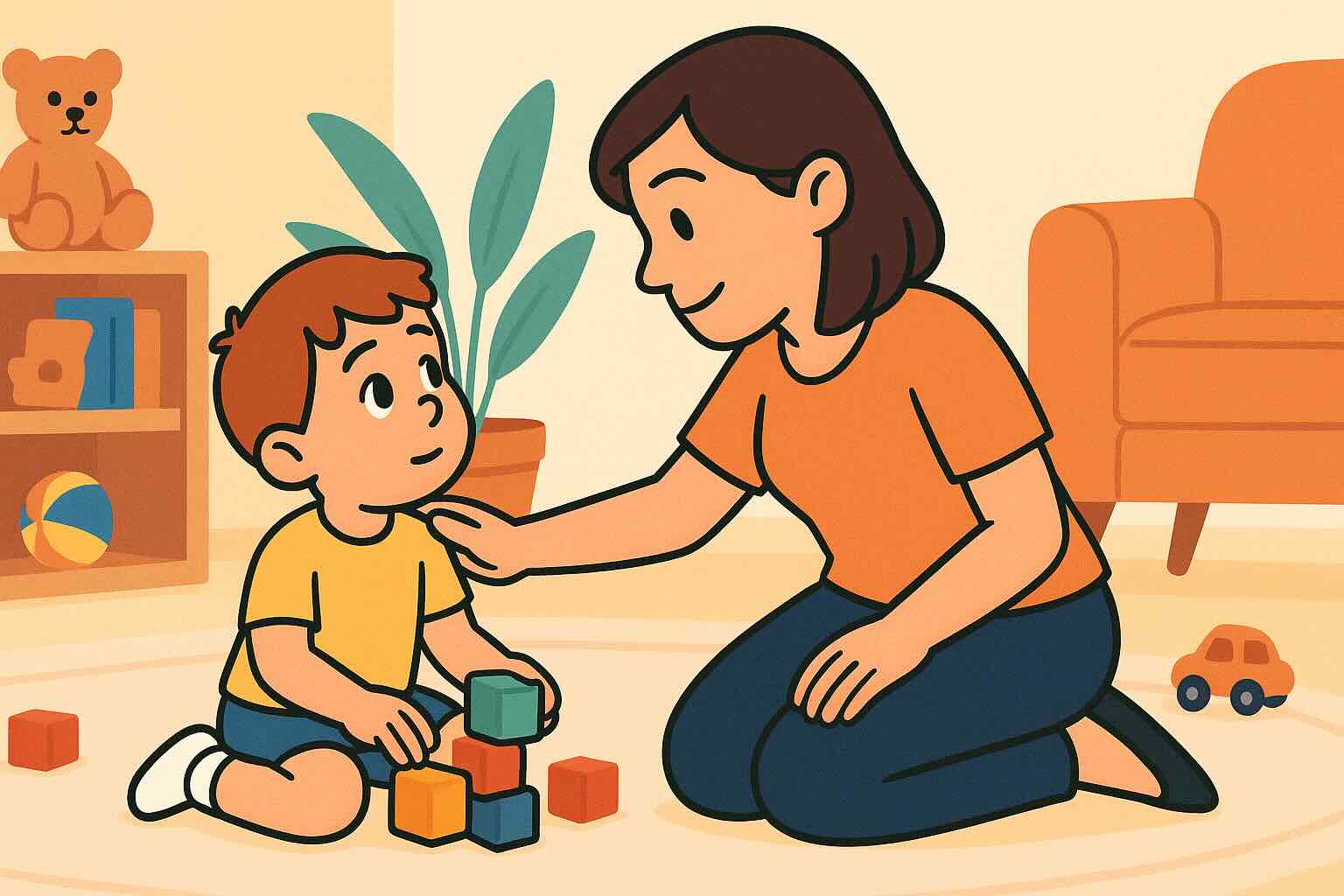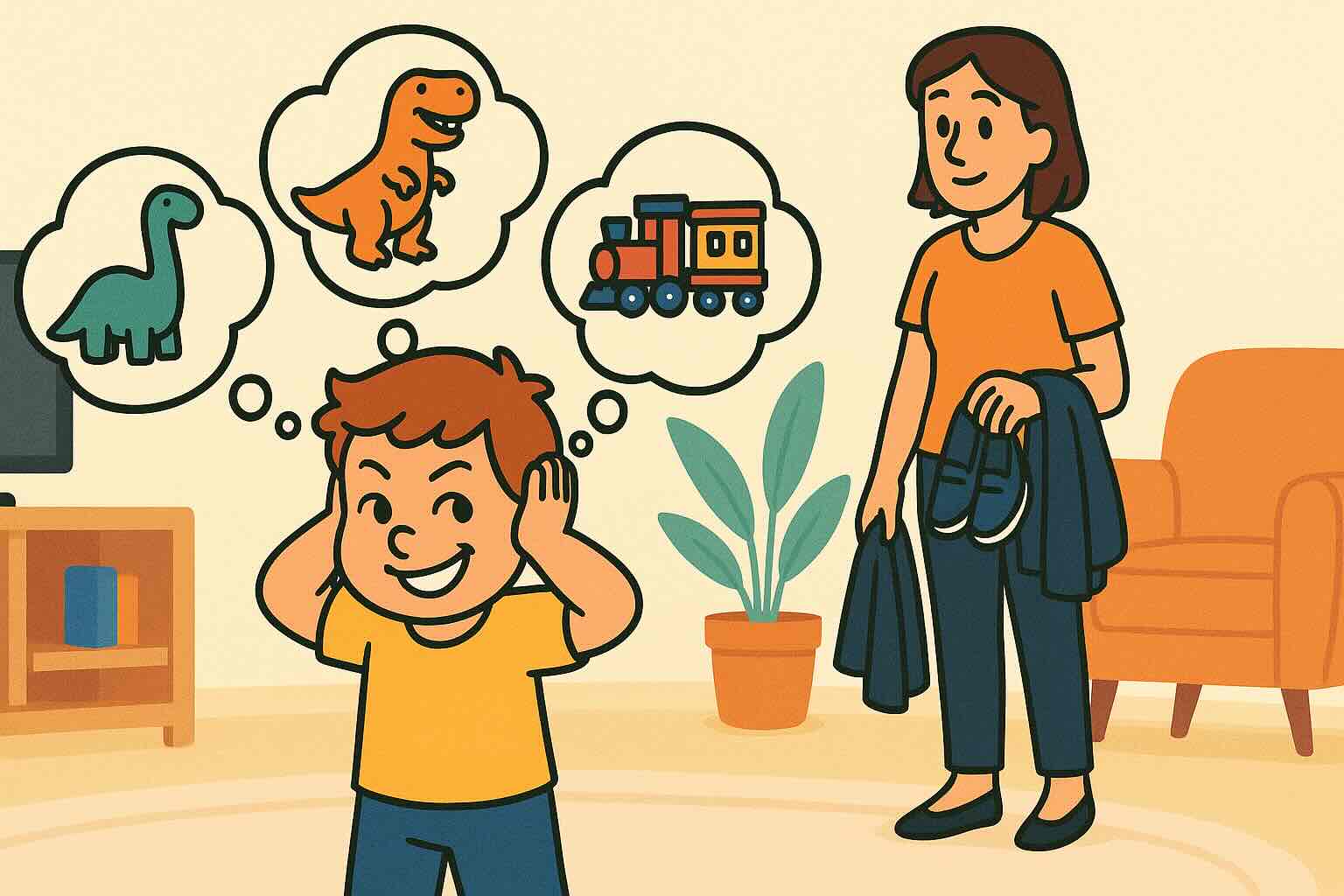Time-In vs Time-Out: 5 Connection Strategies


Picture this: Your 4-year-old hits their sibling and you send them to sit in the timeout chair for 4 minutes. They sit there crying, feeling angry, ashamed, and disconnected from you. When the timer goes off, have they learned to handle frustration better? Or have they just learned that when they have big emotions, they get sent away?
Traditional time-outs are used in 85% of American homes, but research shows they often fail to teach the emotional regulation skills children actually need. Time-in offers a powerful alternative that builds connection while teaching real self-control skills.
This comprehensive guide will show you how to use time-in strategies that actually work for children ages 3-7, helping them develop genuine emotional regulation rather than just compliance through fear of isolation.
What You'll Learn in This Guide
- The Science of Emotional Development - How children's brains learn regulation through connection
- Why Traditional Time-Outs Often Backfire - Understanding the unintended consequences
- The Time-In Approach - Building regulation skills through supported practice
- Age-Specific Time-In Strategies - Different approaches for 3-4 vs. 5-7 year olds
- Practical Scripts and Techniques - Exactly what to say and do during big emotions
- Common Challenges and Solutions - Handling resistance and building consistency
- Creating Calm-Down Spaces - Environmental supports for emotional regulation
Estimated reading time: 13 minutes
The Science Behind Emotional Regulation in Children
How Children's Brains Develop Self-Control
Children ages 3-7 are in a critical period for emotional regulation development. Their brains are building the neural pathways that will determine how they handle stress, frustration, and intense emotions throughout their lives.
Key developmental facts:
- The prefrontal cortex (responsible for self-control) isn't fully developed until the mid-twenties
- Children learn emotional regulation through co-regulation with calm adults
- Repeated experiences of being soothed by caregivers help children develop internal soothing abilities
- Isolation during emotional distress can actually impair the development of regulation skills
The Co-Regulation Process
Co-regulation happens when a calm adult helps a dysregulated child return to a calm state. This process literally builds brain connections that support future self-regulation.
How co-regulation works:
- Child becomes dysregulated (angry, frustrated, overwhelmed)
- Adult stays calm and present (providing safety and connection)
- Child's nervous system begins to match the adult's calm state (through proximity and attunement)
- Child gradually returns to regulation (with adult support and patience)
- Brain pathways strengthen (making future self-regulation easier)
Why Connection Trumps Isolation
Research consistently shows that children learn best when they feel safe and connected. When children are isolated during their most vulnerable emotional moments, several problematic things happen:
- Stress hormones increase, making learning and regulation harder
- Shame and disconnection grow, potentially damaging self-esteem
- Opportunities for teaching regulation skills are missed
- The child may learn to suppress emotions rather than process them healthily
Why Traditional Time-Outs Often Backfire
The Problems with Isolation-Based Discipline
Traditional time-outs operate on the premise that isolation will motivate children to behave better. However, for children ages 3-7, this approach often creates more problems than it solves.
Unintended consequences of traditional time-outs:
- Increased shame and disconnection from parents
- Suppression of emotions rather than learning to manage them
- Power struggles as children resist being sent away
- Missed opportunities to teach actual coping skills
- Potential trauma for sensitive or anxious children
When Time-Outs Seem to "Work"
Some parents report that time-outs appear effective because children comply with demands afterward. However, this compliance often comes from:
- Fear of isolation rather than understanding
- Suppression of emotions rather than regulation
- Desire to reconnect rather than genuine behavior change
This type of compliance doesn't build internal motivation or emotional intelligence - it builds external dependence on punishment to motivate behavior.
The Shame Spiral
When children are repeatedly sent away during their most emotionally vulnerable moments, they may internalize messages like:
- "I'm bad when I have big feelings"
- "My emotions are too much for my parents to handle"
- "I need to hide my feelings to stay connected"
- "I'm only loveable when I'm calm and compliant"
These messages can impact emotional development and mental health for years to come.
The Time-In Alternative: Building Regulation Through Connection
What Time-In Actually Means
Time-in is not about giving in to your child's demands or avoiding consequences for inappropriate behavior. Instead, it's about staying emotionally available while your child learns to navigate big feelings.
Core principles of time-in:
- Presence over isolation: Staying nearby rather than sending them away
- Connection over punishment: Maintaining relationship while addressing behavior
- Teaching over controlling: Building skills rather than forcing compliance
- Support over fixing: Being available without trying to make emotions go away
The Time-In Process
Step 1: Ensure Safety
- Stop any harmful behavior immediately
- Get close to your child (physical proximity helps regulation)
- Use calm, firm language: "I need to keep everyone safe"
Step 2: Stay Present and Calm
- Breathe deeply and regulate your own emotions first
- Resist the urge to lecture or fix the situation immediately
- Offer your calm presence as an anchor for their storm
Step 3: Validate Without Giving In
- Acknowledge their feelings: "You're really angry right now"
- Maintain necessary boundaries: "AND hitting is not okay"
- Use "and" instead of "but" to avoid invalidating their experience
Step 4: Support Self-Regulation
- Offer comfort when they're ready to receive it
- Suggest coping strategies: "Would you like to take some deep breaths with me?"
- Wait patiently for the emotional storm to pass
Step 5: Reflect and Reconnect
- Once calm, briefly discuss what happened: "That was really hard for you"
- Problem-solve together: "What could help you next time you feel that angry?"
- Reconnect through physical affection or shared activity
Age-Specific Time-In Strategies
Ages 3-4: Building Basic Emotional Vocabulary
Young children need simple, concrete support during big emotions. Their language skills are still developing, so focus more on presence and less on verbal processing.
Effective strategies for 3-4 year olds:
During the emotional storm:
- Get down on their level and stay physically close
- Use simple emotion words: "Mad feelings," "Sad feelings," "Angry body"
- Offer physical comfort: Gentle touch, holding if they want it
- Stay calm and wait: Don't rush the process
Supporting regulation:
- Breathing exercises: "Let's breathe like a sleeping bear - slow and deep"
- Sensory support: Soft blanket, favorite stuffed animal, calming music
- Movement: Gentle rocking, walking, or other calming movement
- Simple choices: "Would you like to sit on my lap or next to me?"
Scripts for 3-4 year olds:
- "You have big angry feelings. I'm right here."
- "Your body feels upset. Let's breathe together."
- "That was hard. You're safe with me."
- "Mad feelings are okay. Hitting isn't okay."
Ages 5-7: Developing Self-Awareness and Coping Skills
Children this age can begin to understand their emotions more deeply and participate in developing their own regulation strategies.
Effective strategies for 5-7 year olds:
During the emotional storm:
- Acknowledge the intensity: "This feeling is really big for you right now"
- Offer choices in coping: "Would you like to breathe together or would you like some space?"
- Validate the emotion while maintaining boundaries: "You're disappointed AND we still can't have candy before dinner"
Building self-awareness:
- Emotion identification: "What does anger feel like in your body?"
- Trigger awareness: "What happened right before you started feeling angry?"
- Coping strategy development: "What helps you feel better when you're upset?"
Scripts for 5-7 year olds:
- "I can see this is really frustrating for you. Tell me about it."
- "Your anger makes sense. Let's figure out what to do with these big feelings."
- "You're learning how to handle disappointment. That's hard work."
- "What do you think your anger is trying to tell you?"
Practical Time-In Techniques for Common Situations
Scenario 1: Sibling Conflict
What happens: Your 5-year-old hits their little brother because he knocked down their block tower.
Traditional time-out approach: "Go sit in the time-out chair for 5 minutes!"
Time-in approach:
- Ensure safety: "I need to keep everyone safe. No hitting."
- Stay close to both children: Address the hitter first, then the younger child
- Validate feelings: "You worked really hard on that tower. You feel angry that it got knocked down."
- Maintain boundaries: "AND hitting hurts your brother. I need to keep him safe."
- Support regulation: "Let's take some deep breaths together. Your angry feelings are too big for your body right now."
- Problem-solve: "What could you do next time when you feel that angry?"
Scenario 2: Meltdown Over Screen Time Ending
What happens: Your 4-year-old throws herself on the floor screaming when you say it's time to turn off the tablet.
Traditional time-out approach: "If you don't stop screaming, you're going to your room!"
Time-in approach:
- Stay calm and present: Sit nearby, don't try to talk over the screaming
- Validate the feeling: "You really don't want screen time to end. That's disappointing."
- Maintain the boundary: "AND the timer says screen time is done."
- Offer support: "I'm going to sit right here while you have these big feelings."
- Wait it out: Let the emotion run its course without trying to fix it
- Reconnect: When she's calmer, offer a hug and acknowledge: "That was really hard for you."
Scenario 3: Defiance and Refusal
What happens: Your 6-year-old refuses to clean up their toys and yells "You can't make me!"
Traditional time-out approach: "That's disrespectful! Go to your room until you can be respectful!"
Time-in approach:
- Stay calm: Take a deep breath and avoid taking the bait of the power struggle
- Acknowledge their autonomy: "You're right, I can't make you clean up."
- Maintain expectations: "AND toys need to be cleaned up before dinner."
- Explore the resistance: "It seems like you really don't want to clean up. What's hard about it?"
- Offer support: "Would you like help, or would you like to do it yourself?"
- Natural consequence: "If toys aren't put away, they might get lost or stepped on."
Creating Supportive Environments for Emotional Regulation
Setting Up a Calm-Down Space
A designated calm-down space can support time-in by providing a comforting environment for emotional processing.
Elements of an effective calm-down space:
- Soft textures: Pillows, blankets, stuffed animals
- Sensory tools: Fidget toys, stress balls, noise-reducing headphones
- Visual supports: Feelings charts, breathing exercise cards
- Comfort items: Photos of family, special objects
- Books about emotions: Stories that validate big feelings
Important note: This space should feel safe and welcoming, not punitive. Children should choose to use it, not be sent there as punishment.
Environmental Modifications for Better Regulation
Throughout your home:
- Reduce overstimulation: Lower noise levels, organize spaces, use calming colors
- Create predictability: Visual schedules, consistent routines
- Provide sensory breaks: Quiet spaces, movement opportunities
- Model calmness: Your own emotional regulation sets the tone
Common Challenges and How to Address Them
"My child just gets more upset when I stay close"
This is actually normal and often temporary. Some children need to express their big emotions fully before they can accept comfort.
What to do:
- Stay nearby but don't insist on physical closeness
- Remain calm and available
- Don't take their rejection personally
- Wait for them to signal readiness for connection
"I feel like I'm rewarding bad behavior"
Remember that emotions aren't behavior. You're supporting your child through difficult emotions while still maintaining boundaries about behavior.
Helpful reframe:
- "I'm not rewarding hitting; I'm teaching emotional regulation"
- "I'm not giving in to demands; I'm helping them process disappointment"
- "I'm not ignoring the behavior; I'm addressing the root cause"
"Time-in takes so much longer than time-out"
Initially, yes. But time-in is an investment in your child's long-term emotional health and your relationship.
Consider the long-term benefits:
- Fewer behavior problems over time
- Stronger emotional regulation skills
- Better parent-child relationship
- More cooperation and less resistance
"My partner thinks time-in is too permissive"
This is a common concern when partners have different discipline philosophies.
Strategies for alignment:
- Share research about emotional development
- Start with one parent using time-in consistently
- Focus on results rather than methods
- Consider family counseling if differences are significant
Teaching Self-Regulation Skills
Building Emotional Vocabulary
Help children identify and name their emotions to build self-awareness.
Strategies:
- Emotion charts: Use pictures to help children identify feelings
- Body awareness: "Where do you feel angry in your body?"
- Intensity scales: "Is this big anger or little anger?"
- Emotion books: Read stories about different feelings
Developing Coping Strategies
Work with your child to build a toolkit of regulation strategies.
Age-appropriate coping skills:
- Breathing exercises: "Flower breaths" (smell in, blow out)
- Progressive muscle relaxation: Tense and release muscle groups
- Visualization: Imagine a calm, safe place
- Movement: Jumping jacks, dancing, yoga poses
- Sensory strategies: Stress balls, fidget toys, weighted blankets
Practice During Calm Moments
The best time to teach regulation skills is when everyone is calm and connected.
Proactive teaching:
- Role-play: Practice how to handle frustrating situations
- Read books: Stories about children managing big emotions
- Mindfulness activities: Simple meditation or breathing exercises
- Emotional check-ins: Regular conversations about feelings
The Time-Away Alternative: When You Need Space
Sometimes parents need a break from intense emotions, and that's completely normal and healthy.
When to Use Time-Away
- You feel yourself getting triggered or overwhelmed
- You're worried you might respond harshly
- You need a moment to regulate your own emotions
- Your child specifically asks for space
How to Implement Time-Away
For you:
- "I need a few minutes to calm down. I'll be right back to help you."
- Take 2-5 minutes to breathe, collect yourself
- Return when you feel more regulated
- Resume supporting your child
For your child (if they request it):
- "Would you like some space to calm down?"
- Let them choose where to go (their room, calm-down space)
- Check in periodically: "How are you doing? Ready for a hug?"
- Respect their need for processing time
Your 4-Week Time-In Implementation Plan
Week 1: Observation and Preparation
- Notice when you currently use time-outs or sending away
- Set up a calm-down space in your home
- Practice staying calm during small upsets
- Begin using validation language: "You're feeling..."
Week 2: Basic Time-In Implementation
- Start staying close during emotional moments
- Focus on presence over talking
- Practice the 5-step time-in process
- Notice your own emotional reactions and triggers
Week 3: Building Skills and Consistency
- Introduce simple coping strategies
- Have conversations about emotions during calm moments
- Work on consistency across different situations
- Address any resistance or challenges
Week 4: Refinement and Family Integration
- Evaluate what's working and adjust as needed
- Include your child in creating family emotion rules
- Celebrate progress in emotional regulation
- Plan for long-term maintenance and growth
The Long-Term Benefits: Raising Emotionally Intelligent Children
When you consistently use time-in approaches, you're investing in your child's lifelong emotional health and relational skills.
Children who experience time-in develop:
- Better emotional regulation: Skills for managing stress and frustration
- Stronger relationships: Trust and connection with parents and others
- Higher self-esteem: Feeling worthy of love and support during difficult moments
- Better mental health: Lower rates of anxiety and depression
- Social competence: Understanding and empathy for others' emotions
- Academic success: Better focus and self-control in learning environments
Key Takeaways: Your Time-In Guide
- ✅ Connection builds regulation better than isolation
- ✅ Emotions need support, not punishment or suppression
- ✅ Co-regulation teaches self-regulation through repeated positive experiences
- ✅ Time-in addresses root causes while time-out only addresses symptoms
- ✅ Age-appropriate support looks different for 3-4 vs. 5-7 year olds
- ✅ Your calm presence is the most powerful regulation tool
- ✅ Practice during calm moments builds skills for difficult moments
- ✅ Consistency over perfection - focus on progress, not perfect implementation
- ✅ Long-term relationship benefits outweigh short-term convenience
Remember: Your child doesn't need perfect behavior - they need your loving support as they learn to navigate the complex world of emotions. Time-in isn't about being permissive; it's about being present.
Related Articles
Complete your positive discipline approach with these essential strategies:
- How to End Power Struggles with Children Ages 3-7 - Transform conflicts into cooperation using connection-based solutions
- Setting Boundaries Without Punishment: Complete Guide - Set loving limits that teach self-discipline without harsh consequences
- Building Cooperation Without Rewards: Fostering Internal Motivation - Foster genuine cooperation through intrinsic motivation rather than external rewards
- Natural Consequences vs Punishment: Teaching Responsibility - Use life's natural feedback to teach responsibility and decision-making
This article is based on attachment theory, neuroscience research, and child development principles. Individual experiences vary based on child temperament, family circumstances, and consistency of implementation. Always prioritize safety and consult professionals if you have concerns about your child's emotional development.
24/7 AI Parenting Assistant
Get instant, personalized advice with expert-curated parenting knowledge. Chat with your AI coach anytime, anywhere.

Boundary Setting Scripts
Set firm, loving boundaries without punishment using evidence-based scripts and strategies that build cooperation and respect.
Frequently Asked Questions
Need personalized support?
RootWise's AI coach can provide tailored strategies for your specific situation, available 24/7 when you need it most.
Learn More About AI Coaching →



